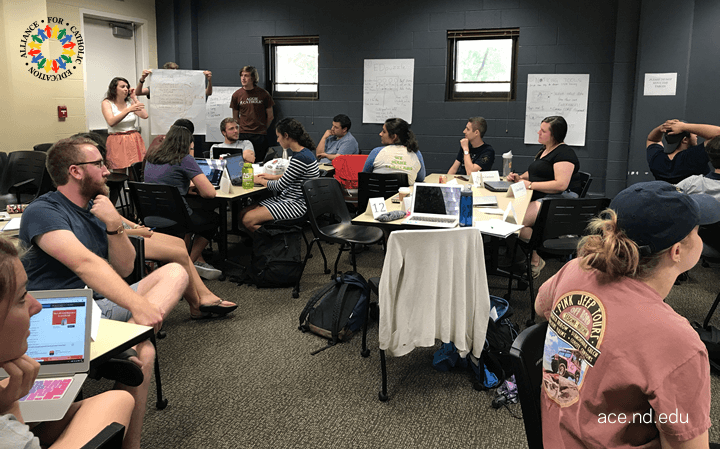The Alliance for Catholic Education (ACE) is perhaps best known for its Teaching Fellows program, which forms talented, faith-filled college graduates to renew and transform Catholic school classrooms. Each year, ACE selects over 90 of the most talented, faith-filled, community-oriented college graduates in the world to begin its two-year service-through-teaching Masters of Education. After two summers of rigorous academic courses and two school years of full-time teaching in a Catholic school as well as completing online coursework, ACE Teaching Fellows graduate as licensed teachers with a M.Ed. and a lifelong commitment to Catholic education. (Side note: Ian Corbett, Mary Kate Veselik, and Sean Wolohan are all graduated ACE Teaching Fellows who taught at Holy Angels this year!).
 The current ACE Teaching Fellows are in their last week of classes here on campus before they set out to teach for the year in schools across the nation. Fr. Nate and I have been fortunate to spend part of this final week of ACE summer with 36 of them who are entering their second year of teaching. These are some of the best and brightest minds in Catholic education, and they have decided to learn more about blended learning by participating in our weeklong course.
The current ACE Teaching Fellows are in their last week of classes here on campus before they set out to teach for the year in schools across the nation. Fr. Nate and I have been fortunate to spend part of this final week of ACE summer with 36 of them who are entering their second year of teaching. These are some of the best and brightest minds in Catholic education, and they have decided to learn more about blended learning by participating in our weeklong course.
The teachers lead classes ranging from second grade to middle-school English to AP Physics and everywhere in between; some teachers are in schools with 1:1 iPad programs, whereas others others only have access to a lab of desktop computers. Regardless of these great differences between the teachers, though, they are united in their steadfast belief that technology can be leveraged to improve student learning and their commitment to do so in their own classrooms.
During our most recent class, we undertook a crash course in data-informed instruction by allowing the teachers to explore the many kinds of data available from software programs and infer how these data could inform instruction. I was already extremely impressed with our amazing students, but their insights from this class in particular blew me away.
 As a whole, many of the teachers echoed this statement: "Data-informed instruction allows teachers to get a clearer look at the strengths and weaknesses of specific students to then restructure learning processes to tailor to specific needs." These teachers know that the data from software programs can help them understand their students' needs at a more granular level than they ever could otherwise and are eager to use it refine their instruction.
As a whole, many of the teachers echoed this statement: "Data-informed instruction allows teachers to get a clearer look at the strengths and weaknesses of specific students to then restructure learning processes to tailor to specific needs." These teachers know that the data from software programs can help them understand their students' needs at a more granular level than they ever could otherwise and are eager to use it refine their instruction.
But perhaps even more importantly, the teachers also understand the limitations of data. "Data should be used as one tool among many that informs instructional decisions," one student wrote. "One diagnostic is not enough to make sweeping changes to instruction. And a teacher's experience, observation, and intuition may still be the single most important tool." These teachers understand that data can empower teachers and students, but software programs only increase a teacher's importance as leader and instructor in the classroom.
Finally, one teacher's comment made me stop in my tracks. "You don't teach to generate data. Data informs your teaching." Mic drop from Seamus Ronan. This teacher clearly understands the tension between using data to celebrate student performance and using data as a tool to inform instruction in the name of increasing student learning. Growth and performance can and should be celebrated, but student data should be a tool in the hands of teachers rather than a trophy in a case.
I can't wait to see what else we learn from these amazing teachers this week and to watch them put blended-learning practices in place in their own classrooms this year! Stay tuned to hear more from our ACE Teaching Fellows in the coming weeks.
Sign up for updates on ACE's Blended Learning Initiatives and receive our blended learning resource guide, "Learning More about Blended Learning: Read, Watch, Explore".
 Alliance for Catholic Education
Alliance for Catholic Education
